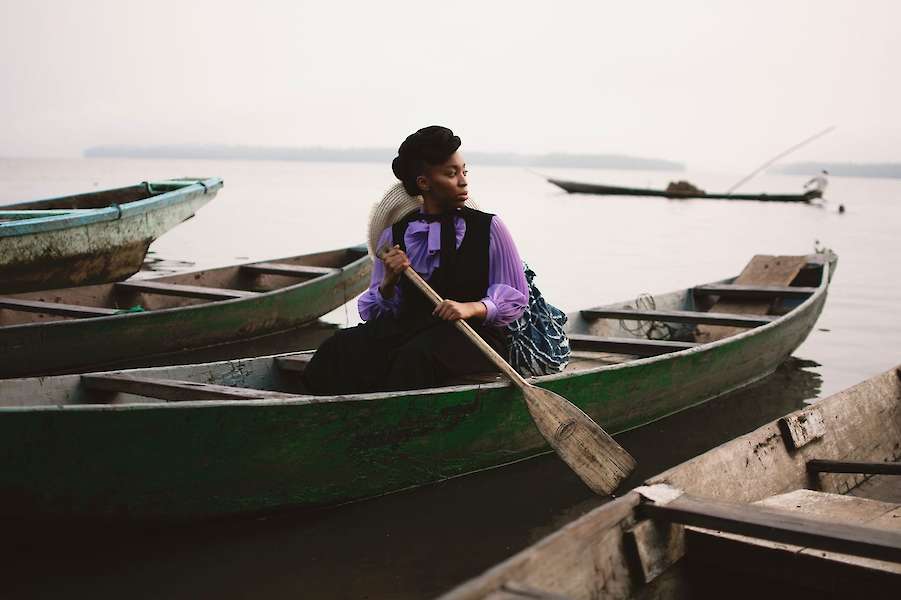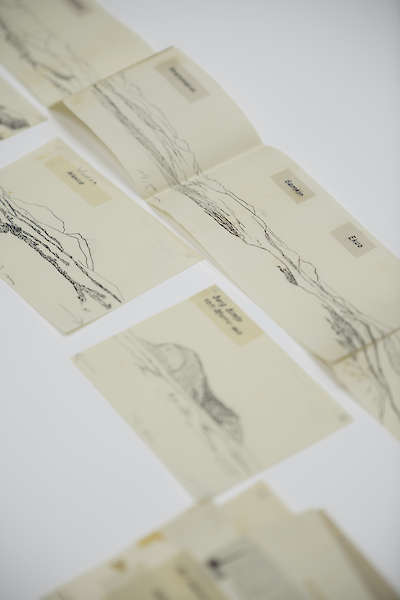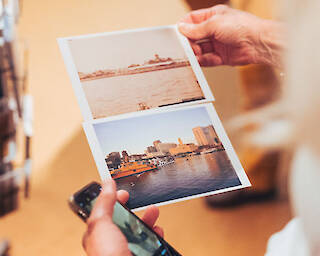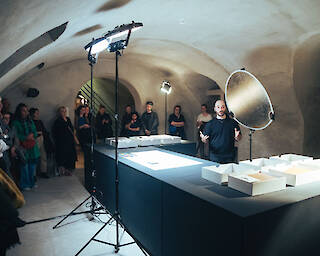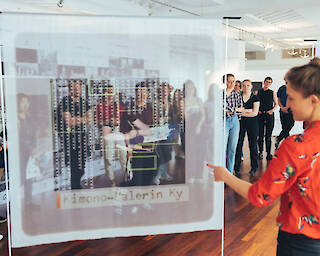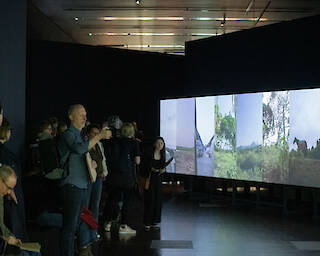Lebohang Kganye in dialogue with the students
of the M.A. program
"Photography Studies and Research"
Students: Lebohang, in many of your previous projects, the material that you work with stems from very personal contexts such as photo albums, narratives, artefacts from the familiar and your own family's context, and it becomes evident in your work that these things are never only personal but embedded in and contingent upon a larger History. For example, photographic albums have been discussed as documents that link private and public narratives. Personal documents have been your point of departure so far through a broad range of depictions: Installation, patchwork, video, performance, and research. As the name of the program Artist meets Archive indicates, in this residency you “met” an archive which is not from a personal or familial background. You engaged with archival objects that are more detached from your experience and memories.
The first question would be: How did you approach this archive? What were the experiences you had while working with different historical contexts and archival material?
Lebohang Kganye: I have mainly been working with personal archives, collaborating with other practitioners within South Africa and still looking at South African history to a large degree. For me, this was a new and different kind of work. I went in very open to the process. I was interested and curious about what sits within ethnographic museum collections, how it looks like, and what was collected from Africa. My starting point was looking at personal archives, because that is my whole practice. I went in looking for family photo albums that had been collected by the museum. They had photo albums, but these were not personal or family photo albums. I continued looking for what was particularly from South Africa and then at what was taken from Africa: photographs and artefacts. I was also curious about what was collected by women and if there had been women in these expeditions. That's how I arrived at the material, and started working with the archive of [german anthropologist, painter and photographer] Marie Pauline Thorbecke (MPT), who had been to Cameroon.
My initial interest was not “mostly photographic”, because for me it was different to the way I usually engage with family photo albums or personal photographs – which is this idea of how people pose for personal photos, especially within the context of the Apartheid period. It had a lot to do with resistance, in terms of people choosing how they wanted to be photographed, remembered, or documented. I think that is a different kind of archive to what sits within the ethnographic museum context.
Looking at the collection of MPT, I started to work with her landscape illustrations, and it got me thinking about drawing as a tool for colonial conquest. Ultimately, I did start incorporating photographs in the second part of the exhibition that you'll see at the museum.
Students: You said you haven't dealt with photographs in an anthropological collection before, was it challenging for you to work at the archive at the Rautenstrauch-Joest-Museum and the collection of Marie Pauline Thorbecke? Can you tell us a bit more about your experience encountering this mass of images in the collection? Did it call for new methods and artistic strategies?
Lebohang Kganye: I think it was challenging because I´ve been working in a particular way for the last ten years. I have centered my research questions around identity and South Africa's past. But when I started going through the collection at the museum there was nothing that “spoke to me” from what was collected.
There's been a lot of discussions around the problematics of photography within that context. I realized how seduced I was by MPT’s landscape illustrations, and how they actually served a different kind of purpose. They were to a large degree, as strong as anthropological photographs which were used as a sort of scientific experiment. It was about weighing these works against each other and what I felt could allow for a new kind of way of thinking about this archival material: Thinking about them as colonial tools. That's what I felt the illustrations offered.
Traveling to the exact sites where archives were built is sort of my methodology. So an important part of the process was going to Cameroon. I engaged with people that lived there because in this case the photographic images and the drawings do not sit outside of the testimonies, the oral histories and the personal memories that people share. It did become a continuation of my practice in that sense. This was similar to the process of producing the work “Ke Lefa Laka: Her-Story” about my mother, for which I went to the exact sites that she'd been photographed.
What was amazing about the AMA residency, was that there was so much material. There were not only the landscape illustrations and the photographs. MPT also published a journal featuring the exact locations that she drew, and descriptions of these locations between 1911-1913, which for me served as a “point of entry”. I went to some of the locations to contrast what she said in the journal and what she drew, and then engage with people that live in those sites today. So it's very much a similar process, it's just not around a “personal” narrative.
Students: You usually refer to yourself as more of a storyteller than a photographer and you place great emphasis on how people tell their stories. The material that you engaged with during the residency is at least a century old. What was the narrative thread that you used to connect it to the contemporary?
Lebohang Kganye: A large part of the work is very much centered around “restitution”. The work does not sit outside of that conversation. What struck me the most when I first encountered the work, outside of the landscape illustrations and how seductive they were, was this idea of what had been collected in the two-three year journey in Cameroon. They had collected so many artefacts and had people carrying them.
I was interested in this idea of the carriers, and so the journey is about this idea of me returning. There's a part in the diary where she speaks about how there's a point in the trip where they had 400 people carrying artefacts, that's how much stuff they had, and brought back to Germany from Cameroon.
The exhibition of the work is meant to be twofold. The main part is sort of a collage: A three-channel-film installation using animated landscapes illustrations and footage of me traveling to some of the exact locations in Cameroon that MPT mentions and returning objects that were taken from there. I went to about eight different cities.
Students: Could your work be described as a counter-archive and a reaction to the representational gaps within official/state archives? Can you think of any times when you were consciously choosing to engage or not engage with certain images because of their political implications?
Lebohang Kganye: Definitely! The challenge of working with and within an ethnographic museum context as a Black woman from South Africa, was that I was aware that a lot of the material might be extremely problematic for me to engage with. Even if I ultimately decided to come back and work with it. So there's the film I’ve just mentioned which is centered around the MPT journal, where she speaks about day to day life in Cameroon, and who they encountered, what she thought about the food, the weather, detailing everything about the experience. The second is an installation consisting of dioramas and based on books that I got on site when I was in Cameroon, which are written by Cameroonians. They are about the memories and different stories that have so far been passed down orally. That for me was important, because I thought that there would be an imbalance in terms of who the narrative is mostly about, and I think that at this point I'm happy with how it's come together.
The installation does actually use a lot of the photographic material – mainly the landscape photographs that MPT took when she was in Cameroon – even though from my end there was quite a resistance. Then it brings in me performing these stories out. The work feels like a continuation of my methodology, in terms of bringing in performance, the oral stories, going to the exact locations, and still working with archival material. Yet it was important to have the “counter narrative” which is from the Cameroonian perspective about that particular period.
So, the exhibition relates in two ways to MPT’s expedition. One is my journey returning these objects, which speaks about a particular moment that we are in. The other is the installation, which is based on oral history that gets passed on, and thinking through the center of the so-called “official history” and private narratives.
Students: Do you relate to methods of narrative-building, where historical data and fictional strands are combined? For instance, Saidiya Hartman’s method of Critical Fabulation aims to fill in the gaps left by historical records, archival absences and raises questions about the representation and visibility of people subjected to colonization and slavery.
Lebohang Kganye: I think that the work challenges the conventional concepts of memory. There are many theoretical frameworks that speak to this idea of gaps that live within memory and within official history and advocate for using personal stories to address them. For me performance is central in terms of thinking about memory and ways of masquerading. It has been important in my work to also use imagination and fantasy as ways to challenge concepts of our “Official Histories” and what has been recorded.
Students: Thank you so much, Lebohang.
This Interview was carried by: Dortje Fink, Sarah Gramotke, Malte Radtki, Gloria Ruiz and Marie Stadelmann.
Lebohang Kganye's exhibition at the Photoszene-Festival 2023
